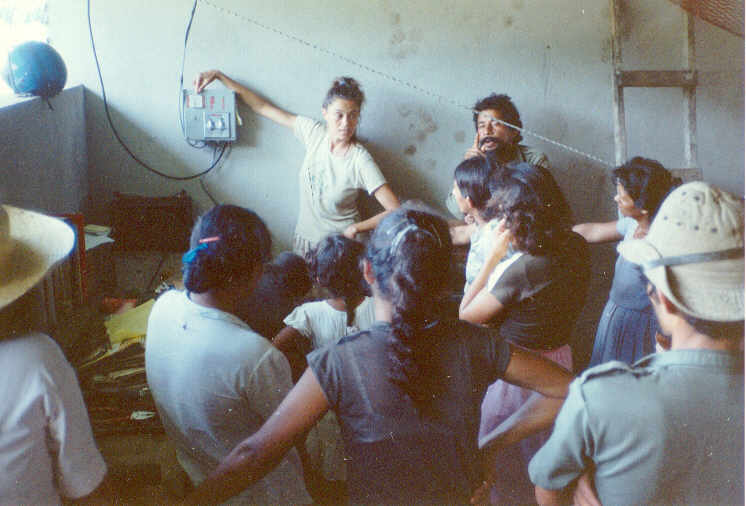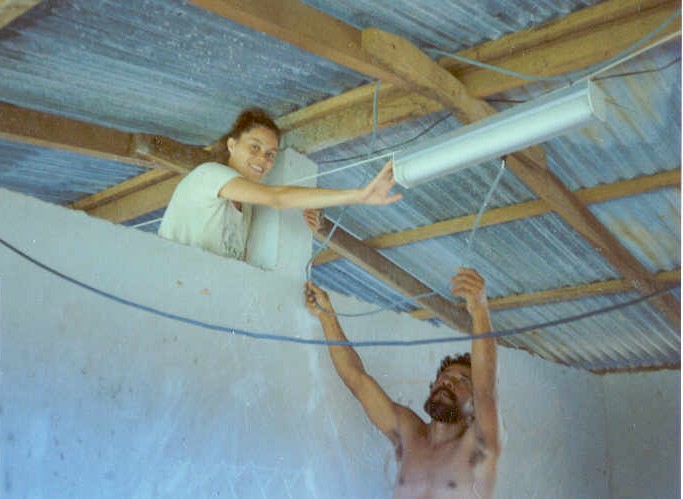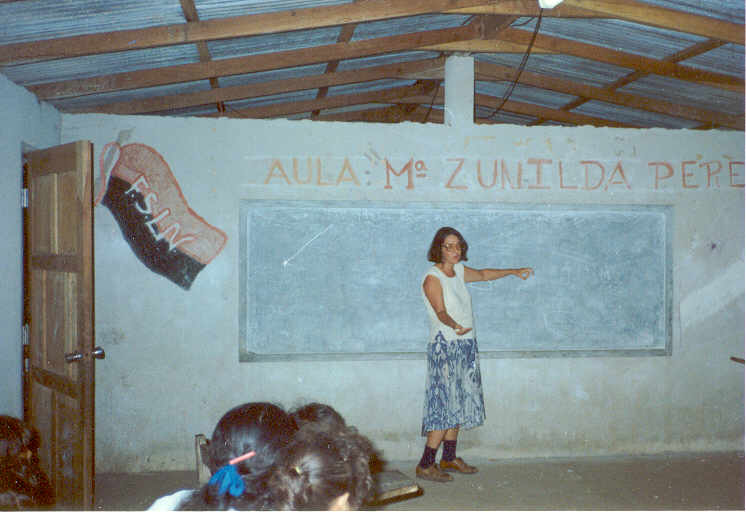Silent Light: TERRASOL's Photovoltaic Installation in Nicaragua
By Barbara Atkinson and Roger Lippman
Terrasol has overseen the installation of four photovoltaic (PV) lighting systems in that country in the past two years. Increasing experience has refined the operation and maintenance of these systems. This article details the experience with the third PV installation in Nicaragua, in November 1988.This article originally appeared in Sunworld, magazine of the International Solar Energy Society, Vol. 13, No.1, March 1989.
It was reprinted in modified form in:
Northern California SUN, magazine of the Northern California Solar Energy Association, Vol. 15, No. 2, Spring 1989; and
Earth Island Journal, Vol. 4, No. 4, Fall 1989.
Roger Lippman and Amancio Perez test the system and measure the panel before installation.
Introduction
Terrasol is a network of people promoting solar energy development in Nicaragua. (1) Some Terrasol members have traveled to Nicaragua and accomplished projects there. One worked with the Institute Nicaraguense de Energia (Nicaraguan Energy Utility - INE) for a year evaluating the country's solar potential. (2) Others have worked on solar monitoring, solar grain drying, solar cookers, and photovoltaic lighting systems. The majority of Terrasol members do support activities in the U.S., designing systems, coordinating volunteers, and doing public outreach and education.
Renewable resources are attractive for Nicaragua because of its dependence on imported oil, the difficulty of fuel transportation and distribution, the limited coverage of the national electricity grid, and the unreliability of the electrical system. The country has abundant solar, small hydroelectric, wind, and biomass resources. Both national and international agencies are evaluating and implementing pilot projects on these technologies. Hydro, geothermal, and sugar mill cogeneration already contribute substantially to Nicaragua's generating capacity. However, the severe economic crisis facing the country has caused a cutback in funds for renewable energy projects. Most active projects are now heavily supported by international personnel and funds. See references below for background information on Nicaragua's energy situation.Terrasol volunteers have installed four photovoltaic lighting systems in the past two years. (3) All of these systems use PV panel(s), a battery, incandescent or fluorescent lights and fixtures (12-volt DC), and some type of voltage regulator. With increasing experience the systems have been refined to make them easier to operate and maintain and less prone to fail. This article deals with our experience with the third PV installation in Nicaragua, in November 1988.
The System: Function, Design and EquipmentIn mid-1988 Terrasol received a request for a lighting system for a rural cooperative in the Second Region. Located to the northeast of Leon close to Esteli, the co-op was founded in 1984 by farmers and agricultural laborers living in the area. Twenty families (about 120 people) grow corn, beans, and vegetables, which they consume or sell to the nearby rural town of Achuapa. Working hard all day, the people wanted electricity to illuminate a school building for night classes and for a sewing collective. As we observed, a small PV system can considerably enhance the quality of life in this type of settlement.
With rather sketchy information and without details from a site visit, we set about designing the system. It consists of one 40-watt PV panel, two 20-watt fluorescent lamps with 12-volt DC ballasts, a 12-volt, 90 amp-hour battery, and a control box including a voltage regulator. We were assisted by Alternative Energy Engineering, Inc, of Garberville, California. (David Katz, President of AEE, installed the first two PV systems in Nicaragua.)We had considerable discussion on how "fail-safe" this system should be. Previous PV installations had encountered problems with overloading by well-meaning co-op members and international aid workers. Even a blown fuse, simple to correct in the developed world, can shut down a system in Nicaragua for months if the person trained to maintain it has moved to another region. While general mechanical skills may be high, the level of understanding of electricity is usually low in the rural areas. The advantage of decentralized power for isolated regions carries with it the disadvantage of lack of familiarity and access to spare parts. It is very important for all installations to have replacement lamps, fuses, wire, etc., since trips to the nearest town may be infrequent and supplies may only be available in the largest cities if at all.
It is possible to design systems that are virtually "idiot proof'. (International workers can be idiots too!) Color-coding, positive and negative connections that fit only one way, and pre-wired controls are features that are incorporated into Terrasol's control systems.
Installation and Training
The system was installed in November 1988 by U.S. volunteers Roger Lippman (4), Barbara Atkinson (5), and Barbara Francis (1), with Nicaraguan assistants at the cooperative. We worked with INPRHU (Instituto de Promocion Humana), a Nicaraguan non-governmental agency that promotes rural development. INPRHU was extremely helpful to us in sponsoring our project and providing transportation to the site. Terrasol and INPRHU are currently collaborating to implement more PV and other solar technologies on Nicaraguan rural cooperatives.
We were aware that the interaction between the recipients of a new technology and those who install it is essential to its acceptance and length of functioning. We made a preliminary visit to the cooperative to initiate contact with the people as well as to investigate the building conditions. Trundling up the heavily-rutted road in a four-wheel-drive vehicle, we appreciated the remoteness of the site. It is doubtful that the utility grid will be extended here in the near future. The cooperative had requested a generator for electricity, but the regional government didn't have the resources to provide it for them or for the many other cooperatives nearby.On arrival we found that an international brigade building houses at the co-op had brought a gasoline generator for its power tools and had also installed some AC fluorescent fixtures. However, the members would be taking the system with them to another cooperative when they left. Even in the meantime, the generator had problems: noise and fuel availability. Gasoline is rationed and when it runs out, it can be months before more is found, paid for, and transported.
During this visit, we discussed uses and location of the lights, noted measurements and orientation of the building, and informed people that we would be returning in a few weeks. Cooperative members were enthusiastic and promised to select a few people to work closely with us during the installation.When we returned to the co-op for the installation, we first connected the PV panel to the battery for testing on the ground in front of the building. Coop members including many children surrounded us curiously. Our solar-powered drill complete with a small panel was of special interest as well as being very useful.
Cooperative members chose three people to work with us; one was a man who had helped found the co-op, and two were women. They told us that since women worked more around the buildings than in the fields they should learn to maintain the system. Training more than one person has the advantage that at least one is likely to be present in case something goes wrong. We made sure that these three (and other interested onlookers) had a chance to handle each component, assist in installation, observe the controls, and try all procedures, even inserting tubes in fixtures and flipping switches. We spoke Spanish and were easily able to describe what we were doing, answer questions, and write up instructions.
Barbara Atkinson reviews control panel operation with co-op members.
Installation was fairly straightforward. The corrugated metal building roof was almost flat and faced east/west. Since the latitude is approximately 12 degrees North, almost any near-horizontal placement of the PV panel would have been adequate. We chose the east orientation since mornings are sunnier than afternoons during the rainy season. On the advice of co-op members we reinforced the metal bracketing with wood since winds can be fairly brisk at the site.
We encountered a two-fold difficulty with the capacity of the system we had brought. First, the building had three rooms and we had two lights. Second, the temporary system (which had only been up for two weeks) had three 40-watt tubes, and ours were 20 watts. Because of the architecture of the rooms, we were able to fasten one fixture on a track so that it could be moved from room to room over the wall between them. This clever feature was very popular, allowing brighter illumination of just one room or use of two rooms depending on the needs of the evening. If this invention proves successful, members will fasten the other fixture to a similar cable to light the third room.
Barbara Atkinson and Amancio Perez try the movable fixture.
To avoid system overload problems experienced at other sites, we used a discharge limiter to regulate system charge. Battery voltage should be between 12 and 14 volts. The limiter turns the system off when this voltage drops below 11.5 volts and back on at 13.5 volts. We explained the operation of the device and advised people to watch the dial on the voltmeter to make sure the needle was in the proper range. They asked us how long they could use the lights; usually they planned to use one or two tubes for only two or three hours a night. We calculated that the battery charged at 12 volts should provide enough current for this amount of usage for up to five consecutive cloudy days. On the occasion of a party (a major holiday was coming in early December) they could probably use both lights for 8 to 10 hours. However we suggested that they monitor the charge level often to avoid the lights turning off and abruptly ending the festivities. The control box also uses a circuit breaker instead of fuses. This eliminates the need for replacement fuses.
Battery maintenance consists of checking battery fluid level and replenishing with pure water if low. Since distilled water is difficult to obtain, rain water can be collected during the rainy season and should be stored for the dry season. Panel maintenance simply involves washing the panel with water during the dry season. We assigned the most inquisitive young boy to protect the panel from possible rock throwing by younger co-op members.
In order to expose the largest number of people to the system, we conducted two training sessions during our visit. The first was a class (also a test of the amount of light in the classroom at night). We drew diagrams of the system, explained the function of each component, and answered questions. We also gave a system "tour", observing each component and asking people questions on operation and maintenance. Finally, we left one system schematic and wiring diagram inside the control box and another with one of the people we worked with. We also wrote an "operations and maintenance manual" (in Spanish) to leave with co-op members.
Under the newly installed photovoltaic lighting system
(barely in picture at top right),
Barbara Francis delivers a concise lesson on solar energy.
During discussion at the end of our stay, people made enthusiastic comments about their new solar lighting. Some had apparently been skeptical that such a system could work, but upon seeing the lights turn on they became believers. They were pleased to have "light without noise." And when we explained that from now on the fuel was free, someone remarked that '"the U.S. can't blockade it!" (6)
Lessons for the Future
After some experience with PV and small hydro systems in developing countries, Terrasol volunteers have learned these lessons for future projects.- Choose a few people to work with you on every step of the installation. They should have some technical ability as well as stability in the community. An ideal situation is to train and compensate someone who can regularly maintain several systems within a region.
- Do high quality work and choose components intended to last a long time. Maintenance can be much more problematic than in the developed world.
- Design systems with unambiguous connections. If an inexperienced person takes something apart, it should only go back together one way. This includes color-coding and unique fittings on critical parts, especially battery terminals.
- Use a discharge limiter to prevent the battery from being discharged too much.
- Instruct people not to overload their systems. Affix written instructions to the battery warning that the system is already at its capacity. Leave written operation and maintenance instructions in the language of the country. Review them and make sure that someone can read them. Leave information including a system schematic in a permanent place such as the control box for the users and other technical workers who may follow you.
Larger Issues and the Rural Energy Coalition
Terrasol's systems serve as demonstrations of PV technology for Nicaraguan rural lighting applications. Since a significant portion of rural communities is not reached by the utility grid, independent systems promoted by international volunteer agencies can serve an important need. However, this raises questions concerning the long-term future of such systems for Nicaraguan energy planning. Which groups can best promote renewable energy in Nicaragua? Which systems are most appropriate for which situations? Should standardization of components be attempted? How can systems be adequately maintained? How are groups inside and outside Nicaragua making such decisions and implementing them?Ongoing discussion and comparison of alternative technologies is important. Small hydro systems on the order of 15-200 kW, some of which are revived installations from earlier in the century, already serve a few towns in the countryside. Other renewable and depletable electricity sources such as wind, diesel, non-rechargeable batteries, kerosene Aladdin lamps, and combinations such as wind/diesel may be appropriate in certain setting. Nicaragua’s shortage of funding for appropriate technology projects makes benefit/cost analyses difficult Nevertheless, both technical and economic feasibility should be analyzed in allocating scarce resources to these projects.
To facilitate discussion of these issues, groups working in renewable energy for developing countries formed the Rural Energy Coalition (REC) in January 1989. Terrasol is a participating member of the Coalition. REC's purposes are:
- to foster communication among first-world renewable energy organizations
- to discuss standards for material, components, and procedures
- to establish training programs and materials for installation, operation, and maintenance of energy technologies
- to design and implement rural energy projects.
REC is supporting a proposed Workshop and Conference on Decentralized Rural Electrification to be held in Central America. The conference is sponsored by one of REC's members, the Rural Electrification Support Project.
Terrasol plans to install several more PV systems in
Nicaragua in 1989. The group is also working on solar ovens and seeking
funding for PV refrigeration systems for rural health centers, and
investigating solar hot water heating for hospitals. To join the Terrasol
network and receive further information, please
FOOTNOTES:
1. Terrasol was founded by Barbara Francis, a long-term tecNICA volunteer working in Nicaragua to promote solar energy development. From 1986-88 she was with the Solar Unit of INE, and now teaches in the Master's Program in Environmental Engineering at the UNI (National Engineering University).
2. Mikos Fabersunne, P.E., is a mechanical engineer in the Engineering Office of the California Energy Commission. He was with lNE's Solar Unit in 1985-86.
3. PV systems installed in Nicaragua are:1) 30-watt system for fluorescent lights in a rural basic grains cooperative dining hall and meeting room,
2) 30-watt system for incandescent lights in a home on a dairy cooperative,
3) The system discussed in this article,
4) 40-watt system for a warehouse at INPRHU's agricultural training center, and
5) Back-up power system for lights and office equipment at the Nicaraguan Women's Institute building in Managua.
4. Roger Lippman is an energy systems specialist employed by the National Center for Appropriate Technology in the USA. He has worked with NicaTech, a Seattle-based Nicaragua technical aid organization.
5. Barbara Atkinson is a mechanical engineer with a Master's degree in Energy and Resources from the University of California, Berkeley. She has worked previously with INE and with the Nicaraguan Ministry of Health as a tecNICA volunteer.
6. This refers to the ongoing embargo by the U.S. government of its former trading partner. Nicaragua has been forced to find other markets for its products and other sources for previously-imported U.S. goods such as machinery and spare parts.
REFERENCES:
Barbara Atkinson. "Nicaragua: Making the Switch." Sunworld, Vol. 9, No.3, 1985.
Barbara Atkinson, Mikos Fabersunne, and James Manwell. "Renewable Energy Technologies in Nicaragua – A Balanced Strategy for Energy Independence," Proceedings, UPADI Pan American Energy Congress, Guatemala City, August 1986.
Barbara Atkinson, Mikos Fabersunne, and James Manwell. "Renewable Energy Technologies in Nicaragua and their Relation to Economic Development," Proceedings, American Solar Energy Society Passive Solar Conference, Portland, Oregon, July 1987.
James F. Manwell, Jon G. McGowan, and Alan Wyatt. "Wind Energy Developments in Central America," Sunworld, Vol. 9, No. 3, 1985.



